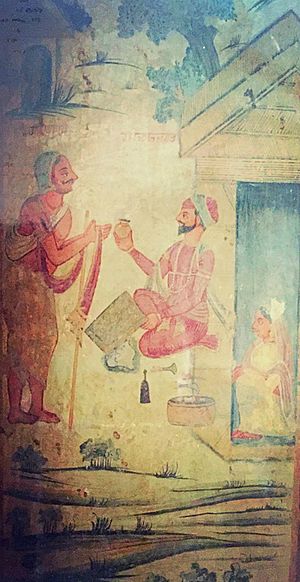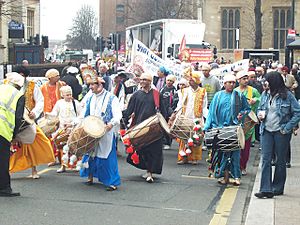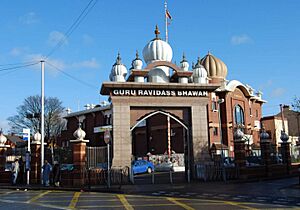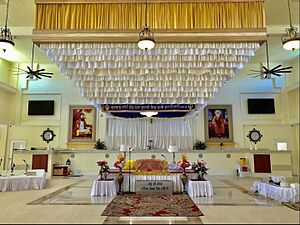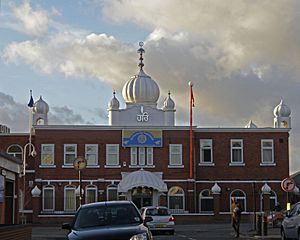Ravidas facts for kids
Quick facts for kids Ravidas |
|
|---|---|
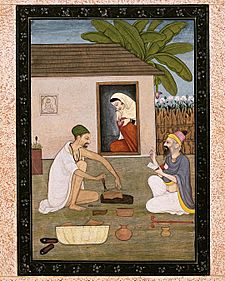
Ravidas at work as a shoemaker. Folio from a series featuring Bhakti saints. Master of the first generation after Manaku and Nainsukh of Guler, Pahari region, ca.1800–1810
|
|
| Birth Date | Banaras, Delhi Sultanate (present-day Varanasi, Uttar Pradesh, India) |
| Died on | Banaras, Delhi Sultanate (present-day Varanasi, Uttar Pradesh, India) |
Ravidas (also known as Raidas) was an important Indian poet and spiritual teacher who lived in the 15th and 16th centuries. He was part of the Bhakti movement, which focused on loving devotion to God. People in many parts of India, like Uttar Pradesh and Punjab, see him as a guru or spiritual guide. He was known for his poetry, for trying to improve society, and for his spiritual wisdom.
We don't know all the exact details about Ravidas's life. Some experts think he was born around 1433 CE. He taught that social divisions, like the caste system and gender differences, should be removed. He believed everyone should be united in their search for spiritual freedom.
Ravidas's devotional poems are found in the Sikh holy book, the Guru Granth Sahib. Many of his poems are also in the Panch Vani text of the Dadu Panthi tradition within Hinduism. He is also the main figure in the Ravidassia religious movement.
Contents
Who Was Ravidas?
Early Life and Family
Ravidas was born in a village called Sir Gobardhanpur, near Varanasi in Uttar Pradesh, India. Today, his birthplace is a special place known as Shri Guru Ravidass Janam Asthan. His birthday is celebrated as Ravidas Jayanti. His mother was Mata Kalsi, and his father was Santokh Dass. His parents belonged to a leather-working community, which was considered an untouchable caste at the time.
Even though his family worked with leather, Ravidas spent most of his time on spiritual journeys near the Ganges River. He often spent time with Sufi saints and other spiritual seekers. When he was 12, Ravidas married Lona Devi, and they had a son named Vijay Dass.
Spiritual Journey and Teachings
Ravidas is traditionally seen as a student of the bhakti-poet Ramananda. He is also thought to have lived around the same time as Kabir, another famous poet-saint.
As Ravidas's ideas and fame grew, people from all backgrounds, including Brahmins, respected him. He traveled a lot, visiting many Hindu holy places across India. He taught about a form of God that is nirguna (without physical form or attributes), rather than saguna (with attributes or images). His poems, written in local languages, inspired many people.
Most experts believe that Ravidas met Guru Nanak, who founded Sikhism. Ravidas is highly respected in the Sikh religion, and 41 of his poems are in the Adi Granth, the Sikh holy book. These poems are some of the oldest records of his ideas.
Ravidas's Writings
The Adi Granth (Sikh holy book) and the Panchvani (a Hindu text) are the two oldest sources of Ravidas's writings. In the Adi Granth, 41 of his poems are included. His poetry talks about important ideas like what a fair society looks like, where everyone is treated equally. He also wrote about the importance of being calm and detached, and what it means to be a true Yogi.
It's important to know that over time, many poems written by other poets were sometimes mistakenly linked to Ravidas. This happened because people admired him so much.
Ravidas's Philosophy
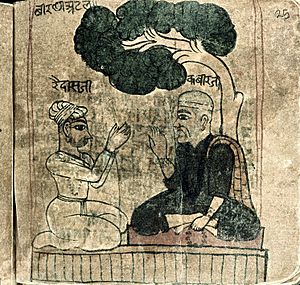
Ravidas's songs discuss ideas about God being Nirguna (without form) and also touch on ideas from Nath Yoga in Hinduism. He often used the word Sahaj, which means a special spiritual state where everything feels connected and true.
Raidas says, what shall I sing?
Singing, singing I am defeated.
How long shall I consider and proclaim:
absorb the self into the Self?
This experience is such,
that it defies all description.
I have met the Lord,
Who can cause me harm?
Hari in everything, everything in Hari –
For him who knows Hari and the sense of self,
no other testimony is needed:
the knower is absorbed.
His poems are full of deep love for God, seen as Nirguna. Many scholars today believe Ravidas's ideas fit into the Nirguna philosophy of the Bhakti movement.
Some old writings from the 18th and 19th centuries show a discussion between Kabir and Ravidas about the nature of God. Kabir believed God was a single, unified reality (monistic). Ravidas, however, argued that God could be both one and also appear in different forms.
Ravidas's Impact
The Ravidassia Religion
The Ravidassia religion is a separate faith that developed in the 21st century. It was started by followers of Ravidas's teachings. After an attack on a Ravidassia temple in Vienna in 2009, where people were injured and one leader died, the movement decided to become a religion completely separate from Sikhism.
The Ravidassia religion created its own holy book called Amritbani Guru Ravidass Ji. This book is based entirely on Ravidas's writings and teachings and contains 240 hymns.
Places of Worship
Ravidas is highly respected by his followers. His places of worship are called dera, sabha, mandir, gurudwara, or bhawan, which are all types of temples.
Outside these places, there is often a flag with the "Harr" symbol, which represents the enlightenment that comes from Guru Ravidas's teachings.
Politics and Influence
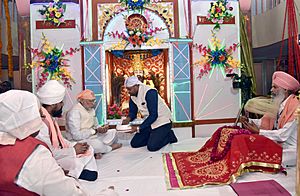
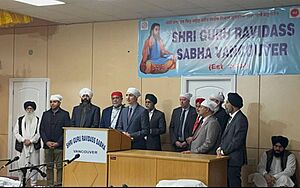
In 2012, a political party was started in India by followers of Ravidas. Its name includes "Begumpura" (Be-gam-pura), a term from one of Ravidas's poems. It means a city without sorrow or fear, where everyone is equal.
The importance of Guru Ravidas's birthday (Jayanti) is so great that India's Election Commission once postponed an election in Punjab because of it. This was a very rare event.
Many political leaders, including Prime Ministers and Chief Ministers, have visited Ravidas temples and participated in Ravidas Jayanti celebrations. This shows how important Ravidas and his followers are in Indian politics. Leaders from different parties often visit his birthplace in Varanasi, especially during election times.
Even international leaders, like former Canadian Prime Minister Justin Trudeau, have visited Guru Ravidass Temples in Canada. He spoke about the principles of "equality" that Guru Ravidas taught, noting that Canada shares these values.
Guru Ravidas and Meera Bai
There is a small pavilion called a chhatri in front of Meera's temple in Chittorgarh district, Rajasthan. It has Ravidas's footprint carved into it. Stories say that Ravidas was the guru (teacher) of Mirabai, another famous poet from the Bhakti movement.
Queen Mira Bai wrote a song dedicated to Guru Ravidas, calling him her Guru.
Sadguru sant mile Ravidas
Mira devaki kare vandana aas
Jin chetan kahya dhann Bhagavan Ravidas
This means: "I found a guru in the form of sant Ravidas, and because of that, I achieved life's fulfillment."
Images for kids
See also
 In Spanish: Ravidas para niños
In Spanish: Ravidas para niños
- Dalit Buddhist movement
- Ramdasia
- Kabir
- Guru Ravidass Jayanti


